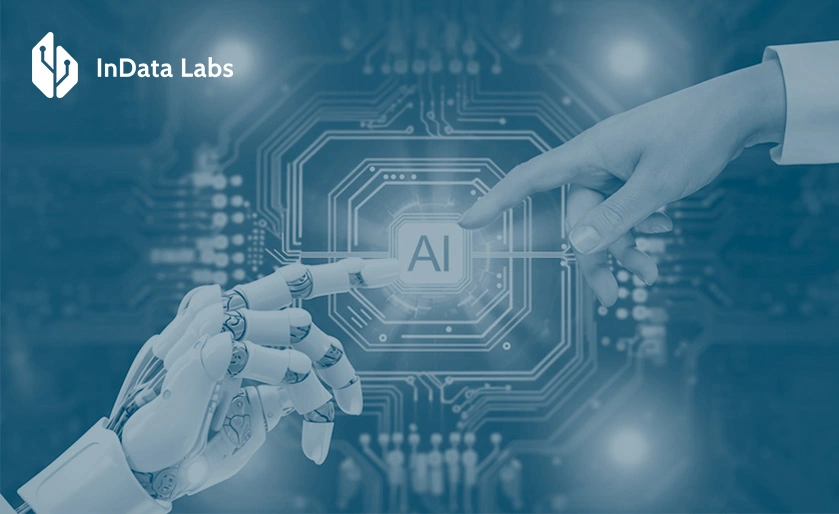If you are a business owner looking to get some help from technology to improve your workload, you might have come across AI – but do you know how to use AI for business analysis? This futuristic approach could help you gain insights, streamline operations, and make data-driven decisions: AI could be your key ally.
Some reports have shown that staff using AI had an 80% improvement in productivity due to this technology. AI enthusiasts know that AI is not here to replace human work, but to improve it and make more room for creative and strategic thinking.

Source: Unsplash
Without a doubt, AI has transformed the digital world as we know it and has made the internet even more accessible and easy to use. This guide will walk you through how to make the most out of artificial intelligence in business analysis while making sure your data is protected.
First things first: AI and business analysis
In today’s business landscape, the combination of business analysis and artificial intelligence (AI) is transforming how organizations analyze data and make strategic decisions. Understanding the role of AI in business analysis is crucial for leveraging its potential to enhance efficiency and drive innovation.
What is AI and why does it matter? Artificial intelligence (AI) refers to systems designed to perform tasks that would typically require human intelligence. These tasks include learning, reasoning, problem-solving, and data analysis.
For businesses, AI can offer many advantages and provide tools that can analyze vast amounts of data quickly and accurately. AI can also get insights and spot data that might be missed by human analysts.
Key benefits of AI for business analysis
Business analysis artificial Iintelligence (AI) is transforming the market by providing innovative solutions that enhance efficiency and decision-making. This technology automates routine tasks and delivers deep insights into things like customer behavior and market trends, which allows businesses to focus their efforts elsewhere.
Want to learn how to use AI for business analysis? First, here are a few ways AI can change how you approach business analysis:
Customer valuable insights
When using AI business analysis tools for customer insights, you will have access to a complete and accurate description of your customers’ behaviour and characteristics. People involved in marketing and sales know how important it is to know your buyer’s persona before designing any type of strategy for a business.
By having all this information from your clients, you can know what they are interested in, what their preferred products or services are, and why. This is invaluable information and metrics for business owners.

Source: Unsplash
AI can even do more and segment customers based on demographics and purchase history; this will create a very strategic map for the sales departments. But, as you might know, AI business analysis tools can do even more, and it can also spot a potential buy by recognizing behavioral patterns in possible buyers. For example, AI may realize that a close segment of your audience is searching for a specific non-related product or service. After that, it might suggest targeting other people with that same interest and helping your business gain more customers by targeting a different but similar niche.
Enhanced data processing
Using a business analysis AI can process and analyze larger data sets at a faster speed than humans, offering quick insights that will allow you to make faster decisions and vote if needed.
As we will learn through this article, this improved data processing can be useful for many processes (such as automating data entry, predictive analytics, customer segmentation, and risk assessment) across all types of businesses; AI business solutions shouldn’t be underestimated.
Improved customer experience with chatbots
Improved customer experience with chatbots is another massive benefit of AI in business analysis. AI-powered chatbots boost customer service by providing instant, accurate, and personalized responses to inquiries; they use Natural Language Processing (NLP) to understand customer requests and handle routine tasks such as answering FAQs and offering product recommendations.
This capability reduces wait times and ensures consistent support around the clock, 24/7. Plus, chatbots can analyze customer data to personalize interactions based on previous behaviors, which leads to a more tailored experience. The use of virtual assistants amplifies these advantages, as they allow businesses to streamline operations and improve engagement.
InData Labs specializes in developing customized virtual assistant tools that meet the needs of organizations. These intelligent chatbots not only enhance customer experience but also provide valuable insights from interactions. By automating routine tasks, InData Labs helps businesses focus on complex issues that require human attention, ultimately driving higher customer satisfaction and loyalty.
Cost reduction
This benefit might come after some time of implementing AI tools for business analysis. Obviously, you are not going to get an instant reduction after implementing it, but you can after a while of good usage.
AI analytics can do similar work to financial experts and work to ensure efficiency and cost-effectiveness. It can easily and quickly help you identify red flags and areas where you can cut expenses, do some maintenance, or prevent unnecessary expensive spending.
Marketing campaign optimization
AI analytics can greatly overcome real-time and similar working performance. AI for marketing can track metrics with a high level of accuracy, like click-through rates, return on ad spend, and conversion rates. They can also pivot their strategy in real time, reducing unnecessary budget spending. Plus, business analysis AI can offer a savvy approach to identifying the most effective channels, formats, or ad types that can help the business achieve higher positive metric results.
This insight is key to deciding which way to go with advertising and how to define the targeted audience. Lots of money can be saved by properly targeting the right people in the right way. Through useful tools and options, such as A/B testing, you can try many different strategies.

Source: Unsplash
Inventory management
Online businesses and eCommerce know that AI is always the way to go when doing inventory. After all, they are the ones tracking your sales and they can quickly and accurately create historical sales data for your market trends. And again, with this useful data sourced by the best AI for business analysis, you can better predict future demands, avoid over- or understocking, and concentrate on your star products.
Automated reporting
Boring routine tasks such as generating reports can also be automated with the best AI for business analysis. This can save a lot of time for your employees and help them concentrate on more logical and creative tasks. This is something some of them will surely thank you for, and you can, of course, always consult with them and have conversations to find the best way to integrate AI with their current tasks.
Improved accuracy
AI inevitably reduces human error, providing more accurate and reliable analysis. This does not mean AI is bulletproof – it might need human reviewing, but it is less likely to make small mistakes. Many companies are incorporating AI into their strategies for these reasons, particularly in the realm of Big data analytics. After all, AI is also present in many tools and apps that we usually use, but the main difference is that we don’t know or pay enough attention.
And now? How to implement an AI business analyst
Introducing AI to your business might feel overwhelming at first, but it’s a chance to boost efficiency, enhance customer experiences, and stay ahead of the competition. More and more companies are realizing the benefits of AI, so it’s important to implement it thoughtfully. By evaluating the available tools and how they fit your specific challenges, you can manage the complexities of AI integration with ease.
Identify your needs
First of all, before diving into any AI consulting tool, you must know with certainty exactly what you want to achieve with this move: Are you looking to improve customer services, forecast sales, or optimize supply chain management? Understanding your goals is elemental here, because there are so many different tools and approaches online, that you could easily get lost in the world of AI possibilities.

Source: Unsplash
Choose the right AI tools for business analysis
Each AI tool is designed for different aspects of business analysis. Here are some popular types and examples:
- Data analytics platforms: Some tools offer AI-powered analytics and visualization features that help you make sense of your data. Some are simpler than others and depending on the amount of insights you want to get, you can investigate the market.
- Predictive analytics services: Predictive analytics services might be a bit harder to find and you might need the advice and expertise of a professional, but it is out there! Many AI tools are specifically made to foresee future trends and behaviors based on historical data.
- Customer relationship management (CRM) systems: You might have heard about these before – AI-enhanced CRMs provide insights into customer interactions and preferences. Plus, they usually include extra solutions like marketing and internal communication tools.
- Automated reporting tools: There exist other tools that can automate the generation of reports and dashboards. You can personalize this depending on the field and size of your industry.
When choosing an AI tool, consider factors such as ease of integration with your existing systems, scalability, and the specific features you need.
Integrate AI tools for business analysis with your existing systems
Once you’ve done an internal analysis and decided which is the right AI tool for you, it’s time to integrate AI into your business. This might involve:
- Connecting data sources: Ensure your AI tools can access and analyze data from all relevant sources, such as your CRM systems if you have any, and all your databases, including the ones coming from your customer data.
- Training your team: If you decide to include AI for your business, you will have to communicate this to your team. Plus, you might have to invest in training them to ensure every single member knows how to effectively use the new tools. Some team members might need more training than others, depending on their positions, but this is up to your internal organization.
- Continuous monitoring and adjustment: AI tools are smart, but they will still need human review and monitoring. They will likely need ongoing adjustments to improve accuracy and relevance. Make sure you regularly review their performance and make the necessary tweaks.
You can of course hire some IT professional to take care of this delicate integration to ensure you go through a smooth process. There is no need for every business owner to know all of this; after all, AI is very new, and only specialists know how to handle every aspect of it.
Good practices for AI in business analysis
As more and more businesses start using AI technologies, it becomes extremely important to develop best practices to make sure these tools work well and integrate into your everyday operations smoothly.
Introducing artificial intelligence in business isn’t just about embracing high-tech gadgets; it involves a careful strategy that covers how you handle data, how you involve key players, and how you keep improving over time.

Source: Unsplash
By sticking to smart practices, companies can truly tap into what AI has to offer, resulting in smarter decisions, better customer experiences, and more efficient operations.
Data quality does matter
The effectiveness of AI in business analysis largely, and obviously, depends on the quality of the data it processes. To have clear and accurate results, you must ensure that your data is:
- Reliable: This will need human intervention and a continuous process of data quality analysis.
- Complete: You must gather comprehensive data to avoid gaps. All the data you collect must make sense of your business goals and tell a story you can later use for analysis.
- Up-to-date: This might sound obvious, but your data should be fresh. Especially during these fast-paced times, people tend to change their customer behavior rapidly, and you don’t want to mix old data with new. This can cause bad insights and mislead your decision.
You must secure your primary resource: protect your data
AI systems will likely handle sensitive information for you, and this is exactly why making them safe should be the top priority to ensure the efficiency of your work. Consider implementing strong security measures to keep your data confidential and your professional reputation intact, especially in the context of generative AI development.

Source: Unsplash
There are many tools and solutions out there that could help you safeguard your data, but not all of them are easy to use or accessible. One effective option is a Virtual Private Network, or VPN. Here’s why:
- They will code your information: VPNs encrypt the data you send and receive while you use the internet, and make it more difficult for unauthorized parties to intercept or corrupt your information.
- Perfect for remote work: VPNs enable secure access to your systems and data, even from remote locations. This could be particularly important for businesses with teams all around the globe. You can also learn how to use a static IP address if you prefer.
- Overall protection against cyber threats: When VPNs code your IP address, what they basically do is protect your devices against various cyber threats and attacks.
Make sure to choose a reputable VPN provider. You will probably find many free options online, but most of them are unfortunately not safe enough. They are likely to sell your data to companies for advertisement and won’t assure security. They can be good for accessing blocked content from foreign countries, but security is not typically their best quality or priority. Plus, due to poor structure, they will probably slow your connection.
Supporting employees in AI-driven data analysis transition
As with any changes in a company, supporting employees during the transition is essential. Change can be daunting, especially when new technologies alter job roles and workflows.
Businesses should provide the necessary tools and resources to help employees adapt in order to foster a positive environment. By framing AI as a professional assistant that empowers them to focus on more strategic tasks, you can encourage your team to embrace this transition with confidence and enthusiasm.

Source: Unsplash
Offer every available tool to make their job easier
Give access to resources related to machine learning in business analytics. This will ensure they accept AI integration with open arms; remember that people tend to see AI as a threat to their job position for a good reason – they know AI can be efficient at many tasks, so make sure they see AI as getting help from a professional, rather than competition.
Encourage a culture of continuous learning
This is positive because they won’t feel like they are only working to pay the bills but also to learn and acquire skills that may benefit them in the future. Plus, this might get them interested in AI and business analysis in general – win-win!

Source: Unsplash
Consider hiring someone as a transition or IT manager
Depending on the budget of your business, you might want to think about a specific role for this that can, firstly, teach them what work is like, and secondly, ensure a smooth transition. Remember – AI for small businesses is a great idea, too. And finally, this is maybe one of the most important tips:
Make sure to communicate that things will stay the same
Their peace of mind is key for them to trust AI and willingly learn how to implement it and work alongside it. Even the most tech-savvy data analyst can feel threatened by AI, and it is the leader’s job to bring some tranquility to the team.
You should probably know that it’s not all up in this journey and that while AI and companies using generative AI can be a valuable tool, it is impossible for it to replace human business analysts fully.
The main challenge lies in the fact that IT solutions are not capable of coming up with creative or ingenious answers to problems. Plus, they might miss some subtle context that the human eye can easily spot. AI has a limited word capacity, and you will need to integrate both the efficiency of AI with the depth that only the human condition can understand so far.
Think about, for example, interviews: even if they are recorded or digital, a human mind can easily spot moods and nonverbal communication in these interactions, while the AI might not. Human analysts are the best at these tasks; they can read body language and voice sentiment during human interactions. A skilled analyst or worker should be capable of efficiently extracting information from AI tools, learning how to use AI for business analysis and applying it to improve their work.
One last advice: Start small
Businesses should implement artificial ntelligence services in small doses. This is the best approach to spot strengths and weaknesses when implementing, plus it will give your team time to get used to it. You might feel the rush to do it all at once, but that’s a mistake. When starting small, organizations can also demonstrate their value to clients and stay organized.
Conclusion
AI companies are definitely transforming the way businesses and professionals see their work and value. It offers unprecedented opportunities to gain insights, enhance efficiency, and drive growth.
AI will soon be a must for every business out there that wants to succeed in the competitive modern world. After all, there were more than 250 million users of AI tools around the world in 2024. Are you ready to take your business analysis to the next level with AI? Dive in, explore the tools available, and watch as your data transforms into actionable insights that drive success.



